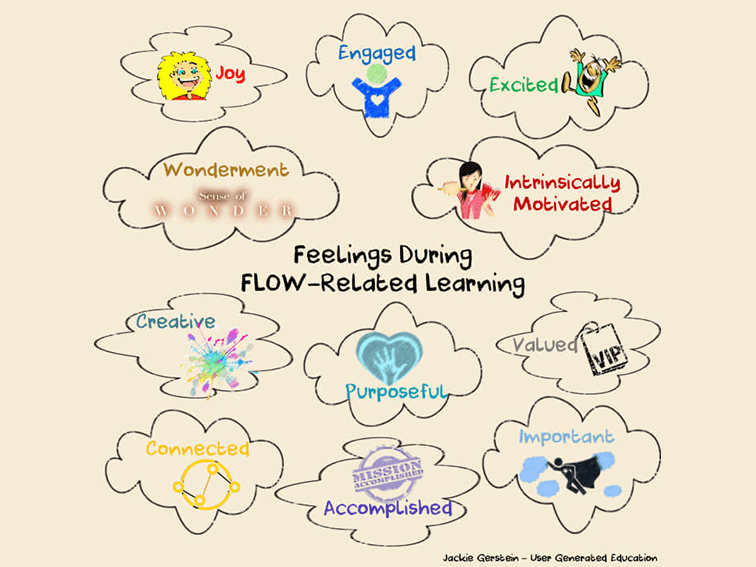contributed by Jackie Gerstein
Watch children, youth, and even adults when they are immersed in learning something interesting, and you will often see complete engagement and personal joy.
When education is done ‘right,’ learners often feel and experience the following in their both formal and informal educational environments:
- Joy
- Engaged
- Excited
- Wonderment
- Intrinsically Motivated
- Creative
- Accomplishment and Pride (in themselves and in their work)
- Connected (to the content, to other learners, to experts)
- Purposeful
- Important
- Valued
All of these feelings described above are often experienced as part of a FLOW state. The characteristics of “Flow” according to its originator and researcher, Czikszentmihalyi, are:
- Completely involved, focused, concentrating – with this either due to innate curiosity or as the result of training
- Sense of ecstasy – of being outside everyday reality
- Great inner clarity – knowing what needs to be done and how well it is going
- Knowing the activity is doable – that the skills are adequate, and neither anxious or bored
- Sense of serenity
- Timeliness – thoroughly focused on present, don’t notice time passing
- Intrinsic motivation – whatever produces “flow” becomes its own reward.
Joy and engagement are intentionally at the top of the list as I believe these two feelings are needed in order for all others to occur, for flow to occur. First and foremost, for me, is my desire to help learners experience joy in the learning process:
Building on a child’s ability to feel joy, rather than pushing it aside, wouldn’t be that hard. It would just require a shift in the education world’s mindset. Instead of trying to get children to buckle down, why not focus on getting them to take pleasure in meaningful, productive activity, like making things, working with others, exploring ideas, and solving problems? These focuses are not so different from the things to which they already gravitate and in which they delight.
Joy: A Subject Schools Lack
As for student engagement . . .
Student engagement, described as the tendency to be behaviorally, emotionally, and cognitively involved in academic activities, is a key construct in motivation research (Thijs & Verkuyten, 2009). Consequently, compared to less engaged peers, engaged students demonstrate more effort, experience more positive emotions and pay more attention in the classroom (Fredricks, Blumenfeld, & Paris, 2004). Further, engagement has also been associated with positive student outcomes, including higher grades and decreased dropouts (Connell, Spencer, & Aber, 1994).
I wholeheartedly believe that one of the roles and responsibilities of the modern educator is to set up the conditions for learners to experience flow. Creating a state of flow in the educational environment isn’t, nor does it need to be, that complicated. It can be as simple as replicating real life learning in more formal schools. I have discussed this in my post Natural Versus Unnatural Learning. In real life, learners learn through . . .
- Setting up environmental conditions for themselves – often in comfortable furniture sitting and laying in positions that work for them; eating and drinking when desired; going to the bathroom when needed and by not asking for permission.
- Moving around and engaging in distractions which can help in processing information.
- Asking others for information, ideas, and help on an as-needed basis.
- Getting online to explore personalized inquiry about the content they are learning about.
- Interacting intimately with content-related, real-life objects.
- Learning in a context where learning real-world applications. Deep and meaningful learning occurs within a context.
- Watching and learning from those more experienced than them. With technology, this observation can come in the form of videos, social media, and live communication networks such as Zoom or Google Meet.
Given a growth and flexible mindset, educators can easily implement these ideas within their own classrooms.
